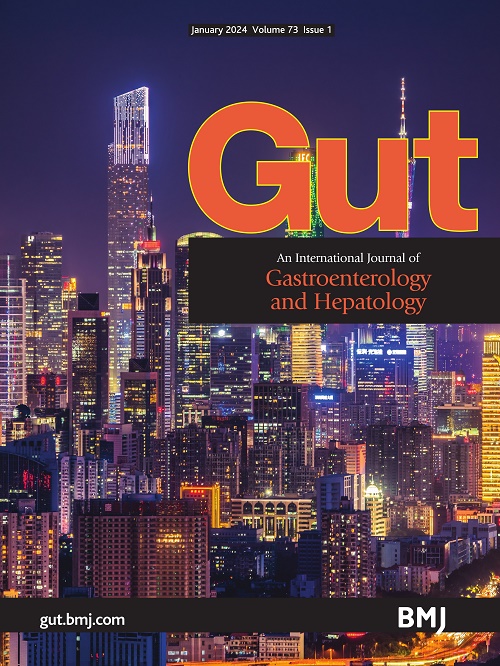长链硫脂富集是导管内乳头状粘液瘤(IPMN)相关胰腺癌的一种可操作的代谢易感性。
IF 23
1区 医学
Q1 GASTROENTEROLOGY & HEPATOLOGY
引用次数: 0
摘要
背景:我们对与导管内乳头状粘液瘤(IPMNs)进展相关的转录组学和代谢组学改变进行了综合跨物种空间评估,IPMNs是胰腺导管腺癌(PDAC)的真正囊性前体。目的揭示IPMNs向PDAC恶性发展的生化和分子驱动因素。设计矩阵辅助激光解吸/电离(MALDI)质谱(MS)为基础的空间成像和Visium空间转录组学(ST)对人类切除的IPMN/PDAC组织(n=23)以及突变的Kras;Gnas小鼠IPMN/PDAC模型的胰腺进行了研究。使用CRISPR/cas9技术、小干扰rna和药理抑制对小鼠IPMN/ pdac衍生的Kras;Gnas细胞进行功能研究。结果患者组织的smaldi - ms分析显示,长链羟基化硫脂在IPMN/PDAC的肿瘤上皮中选择性富集。综合ST分析显示,参与硫脂生物合成的同源转录物,包括UGT8、Gal3St1和FA2H,与硫脂富集区域共定位。在Kras;Gnas IPMN/PDAC细胞中基因敲除或药理抑制UGT8可降低FA2H和Gal3ST1的蛋白表达,从而导致线粒体形态改变和线粒体呼吸减少。小分子抑制UGT8通过神经酰胺介导的代偿性有丝分裂和激活内在凋亡途径引发抗癌作用。在体内,抑制UGT8抑制Kras、Gnas和Kras、Tp53、Gnas小鼠衍生的小鼠IPMN/PDAC细胞异体移植模型中的肿瘤生长。结论:我们的研究发现,在胰腺囊性癌前病变中,硫脂代谢增强是一种早期代谢改变,这种改变通过侵袭性瘤变持续存在,并且在ipmn衍生的PDAC中存在潜在的可操作脆弱性。本文章由计算机程序翻译,如有差异,请以英文原文为准。
Long-chain sulfatide enrichment is an actionable metabolic vulnerability in intraductal papillary mucinous neoplasm (IPMN)-associated pancreatic cancers.
BACKGROUND
We conducted an integrated cross-species spatial assessment of transcriptomic and metabolomic alterations associated with progression of intraductal papillary mucinous neoplasms (IPMNs), which are bona fide cystic precursors of pancreatic ductal adenocarcinoma (PDAC).
OBJECTIVE
We aimed to uncover biochemical and molecular drivers that underlie malignant progression of IPMNs to PDAC.
DESIGN
Matrix-assisted laser desorption/ionisation (MALDI) mass spectrometry (MS)-based spatial imaging and Visium spatial transcriptomics (ST) was performed on human resected IPMN/PDAC tissues (n=23) as well as pancreata from a mutant Kras;Gnas mouse model of IPMN/PDAC. Functional studies in murine IPMN/PDAC-derived Kras;Gnas cells were performed using CRISPR/cas9 technology, small interfering RNAs, and pharmacological inhibition.
RESULTS
MALDI-MS analyses of patient tissues revealed long-chain hydroxylated sulfatides to be selectively enriched in the neoplastic epithelium of IPMN/PDAC. Integrated ST analyses showed cognate transcripts involved in sulfatide biosynthesis, including UGT8, Gal3St1, and FA2H, to co-localise with areas of sulfatide enrichment. Genetic knockout or pharmacological inhibition of UGT8 in Kras;Gnas IPMN/PDAC cells decreased protein expression of FA2H and Gal3ST1 with consequent alterations in mitochondrial morphology and reduced mitochondrial respiration. Small molecule inhibition of UGT8 elicited anticancer effects via ceramide-mediated compensatory mitophagy and activation of intrinsic apoptosis pathways. In vivo, UGT8 inhibition suppressed tumour growth in allograft models of murine IPMN/PDAC cells derived from Kras;Gnas and Kras;Tp53;Gnas mice.
CONCLUSION
Our work identifies enhanced sulfatide metabolism as an early metabolic alteration in cystic precancerous lesions of the pancreas that persists through invasive neoplasia and a potential actionable vulnerability in IPMN-derived PDAC.
求助全文
通过发布文献求助,成功后即可免费获取论文全文。
去求助
来源期刊

Gut
医学-胃肠肝病学
CiteScore
45.70
自引率
2.40%
发文量
284
审稿时长
1.5 months
期刊介绍:
Gut is a renowned international journal specializing in gastroenterology and hepatology, known for its high-quality clinical research covering the alimentary tract, liver, biliary tree, and pancreas. It offers authoritative and current coverage across all aspects of gastroenterology and hepatology, featuring articles on emerging disease mechanisms and innovative diagnostic and therapeutic approaches authored by leading experts.
As the flagship journal of BMJ's gastroenterology portfolio, Gut is accompanied by two companion journals: Frontline Gastroenterology, focusing on education and practice-oriented papers, and BMJ Open Gastroenterology for open access original research.
 求助内容:
求助内容: 应助结果提醒方式:
应助结果提醒方式:


